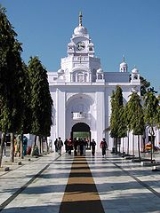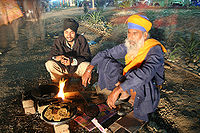
Fatehgarh Sahib
Encyclopedia
Fatehgarh Sahib is headquarters of Fatehgarh Sahib district
, one of the twenty districts in the state of Punjab in North-West India
.
 The city is an historically important town north of Patiala, especially for the Sikh
The city is an historically important town north of Patiala, especially for the Sikh
faith. Gurudwara Fatehgarh Sahib, marks the site of the live entombment of the two younger sons, Sahibzada Fateh Singh
and Sahibzada Zorawar Singh
of the tenth Guru of the Sikhs, Sri Guru Gobind Singh
on 12 December 1705, by the Governor of Sirhind, Wazir Khan, the place is the today commemorated by Gurdwara Fatehgarh Sahib
, 5 km (3.1 mi) north of the Sirhind.
The name 'Fatehgarh', refers to the 'Town of Victory', because in 1710 Sikhs under the leadership of Banda Bahadur overran the area and razed the fort that was built during Balban's
rule to the ground.
 Gurudwara Jyoti Sarup Sahib is about 1 km from Fatehgarh Sahib on Sirhind- Chandigarh road. It was at this place that the mortal remains of Mata Gujri
Gurudwara Jyoti Sarup Sahib is about 1 km from Fatehgarh Sahib on Sirhind- Chandigarh road. It was at this place that the mortal remains of Mata Gujri
, the mother of Guru Gobind Singh and his two younger sons, Sahibzada Fateh Singh
and Sahibzada Zorawar Singh
were cremated. Wazir Khan, the then Faujdar of Sirhind refused to allow the cremation of the bodies unless the land for the cremation was purchased by laying gold coins on it. Todar Mal, who was an ardent devotee of Guru Gobind Singh, purchased this place of land by offering gold coins as demanded. And thus etched his name in the annals of Sikh history and earned the salutation of Deewan.
The town is surrounded by four memorial gates, each in the memory of four important figures from the Sikh
history associated with Sirhind. These are: Deewan Todar Mal, Nawab Sher Muhammed Khan, Baba Banda Singh Bahadur and Baba Moti Ram Mehra. Each person belonged to different caste
s/religions, thus depicting the harmony and brotherhood among people of those times.
_at_fatehgarh_sahib_gurdwara,_punjab,_india.jpg) Sirhind is famous for renowned Mujaddad Alif Saani - Sheikh Ahmad Farooqi Sirhindi
Sirhind is famous for renowned Mujaddad Alif Saani - Sheikh Ahmad Farooqi Sirhindi
(Rh), great sufi saint a founder and repairer of Naqshbandi
- Majaddaddi school of Sufiism and graceism. His and his sons Hz. Masoom Sahib's and various others mausoleum is there, 200 metres (650') from Gurdwara Fateh Garh.
Fatehgarh Sahib district
Fatehgarh Sahib district , is one of the twenty two districts in the state of Punjab in North-West Republic of India, with its headquarters in the city of Fatehgarh Sahib....
, one of the twenty districts in the state of Punjab in North-West India
India
India , officially the Republic of India , is a country in South Asia. It is the seventh-largest country by geographical area, the second-most populous country with over 1.2 billion people, and the most populous democracy in the world...
.
History

Sikh
A Sikh is a follower of Sikhism. It primarily originated in the 15th century in the Punjab region of South Asia. The term "Sikh" has its origin in Sanskrit term शिष्य , meaning "disciple, student" or शिक्ष , meaning "instruction"...
faith. Gurudwara Fatehgarh Sahib, marks the site of the live entombment of the two younger sons, Sahibzada Fateh Singh
Sahibzada Fateh Singh
Sahibzada Fateh Singh was the youngest of Guru Gobind Singh's four sons. He and his older brother, Sahibzada Zorawar Singh are among the most hallowed martyrs in Sikhism. He is also known as Baba Fateh Singh...
and Sahibzada Zorawar Singh
Sahibzada Zorawar Singh
Sahibzada Zorawar Singh was the third of Guru Gobind Singh's four sons. He and his younger brother, Sahibzada Fateh Singh are among the most hallowed martyrs in Sikhism....
of the tenth Guru of the Sikhs, Sri Guru Gobind Singh
Guru Gobind Singh
Guru Gobind Singh is the tenth and last Sikh guru in a sacred lineage of ten Sikh gurus. Born in Patna, Bihar in India, he was also a warrior, poet and philosopher. He succeeded his father Guru Tegh Bahadur as the leader of Sikhs at a young age of nine...
on 12 December 1705, by the Governor of Sirhind, Wazir Khan, the place is the today commemorated by Gurdwara Fatehgarh Sahib
Gurdwara Fatehgarh Sahib
Gurudwara Fatehgarh Sahib is named so, because it marks the conquest of the Sikhs in 1710 when under the leadership of Banda Bahadur, the Sikhs ran over the area and razed the fort to the ground.-History:...
, 5 km (3.1 mi) north of the Sirhind.
The name 'Fatehgarh', refers to the 'Town of Victory', because in 1710 Sikhs under the leadership of Banda Bahadur overran the area and razed the fort that was built during Balban's
Ghiyas ud din Balban
Ghiyasuddin Balban was ninth sultan of the Mamluk dynasty who ruled from 1266 to 1287.-Biography:He was son of a Central Asian Turkic noble of the Ilbari tribe, but as a child he was captured by Mongols and sold as a slave at Ghazni...
rule to the ground.

Mata Gujri
Mata Gujri was the wife of Guru Tegh Bahadur, the ninth Guru of Sikhism, and the mother of Guru Gobind Singh, the tenth Guru of Sikhism...
, the mother of Guru Gobind Singh and his two younger sons, Sahibzada Fateh Singh
Sahibzada Fateh Singh
Sahibzada Fateh Singh was the youngest of Guru Gobind Singh's four sons. He and his older brother, Sahibzada Zorawar Singh are among the most hallowed martyrs in Sikhism. He is also known as Baba Fateh Singh...
and Sahibzada Zorawar Singh
Sahibzada Zorawar Singh
Sahibzada Zorawar Singh was the third of Guru Gobind Singh's four sons. He and his younger brother, Sahibzada Fateh Singh are among the most hallowed martyrs in Sikhism....
were cremated. Wazir Khan, the then Faujdar of Sirhind refused to allow the cremation of the bodies unless the land for the cremation was purchased by laying gold coins on it. Todar Mal, who was an ardent devotee of Guru Gobind Singh, purchased this place of land by offering gold coins as demanded. And thus etched his name in the annals of Sikh history and earned the salutation of Deewan.
The town is surrounded by four memorial gates, each in the memory of four important figures from the Sikh
Sikh
A Sikh is a follower of Sikhism. It primarily originated in the 15th century in the Punjab region of South Asia. The term "Sikh" has its origin in Sanskrit term शिष्य , meaning "disciple, student" or शिक्ष , meaning "instruction"...
history associated with Sirhind. These are: Deewan Todar Mal, Nawab Sher Muhammed Khan, Baba Banda Singh Bahadur and Baba Moti Ram Mehra. Each person belonged to different caste
Caste
Caste is an elaborate and complex social system that combines elements of endogamy, occupation, culture, social class, tribal affiliation and political power. It should not be confused with race or social class, e.g. members of different castes in one society may belong to the same race, as in India...
s/religions, thus depicting the harmony and brotherhood among people of those times.
_at_fatehgarh_sahib_gurdwara,_punjab,_india.jpg)
Ahmad Sirhindi
Imām Rabbānī Shaykh Ahmad al-Farūqī al-Sirhindī was an Indian Islamic scholar from Punjab, a Hanafi jurist, and a prominent member of the Naqshbandī Sufi order. He is described as Mujaddid Alf Thānī, meaning the "reviver of the second millennium", for his work in rejuvenating Islam and opposing...
(Rh), great sufi saint a founder and repairer of Naqshbandi
Naqshbandi
Naqshbandi is one of the major Sufi spiritual orders of Sufi Islam. It is considered to be a "Potent" order.The Naqshbandi order is over 1,300 years old, and is active today...
- Majaddaddi school of Sufiism and graceism. His and his sons Hz. Masoom Sahib's and various others mausoleum is there, 200 metres (650') from Gurdwara Fateh Garh.
External links
- Official website
- http://www.whereincity.com/photo-gallery/gurudwaras/fatehgarh-sahib-205.htm

